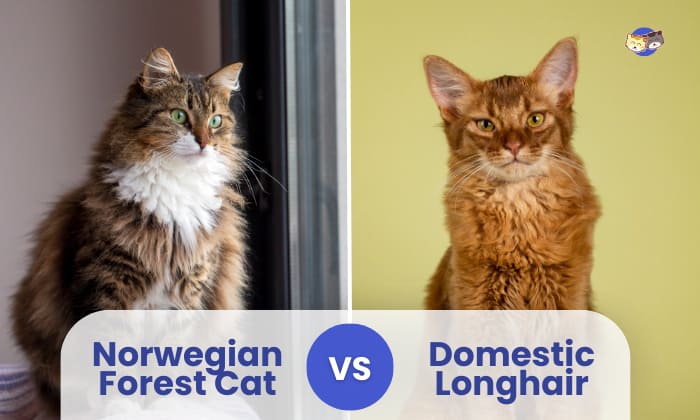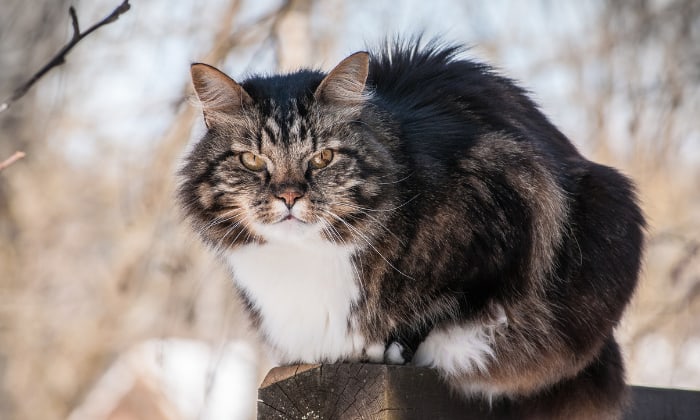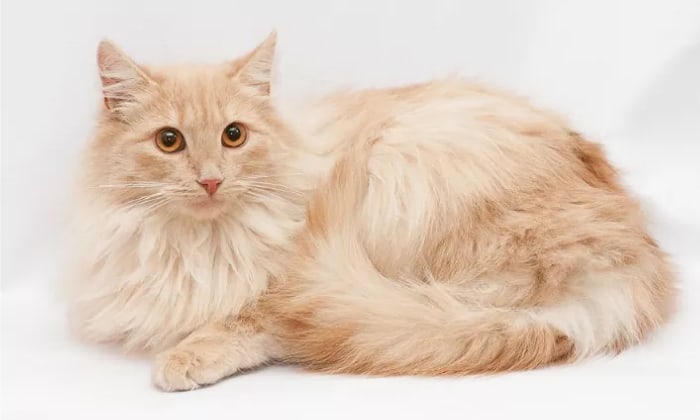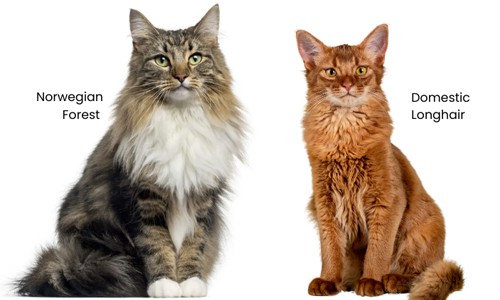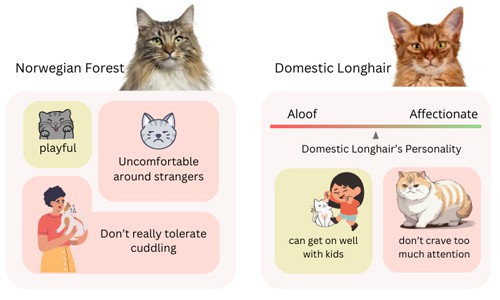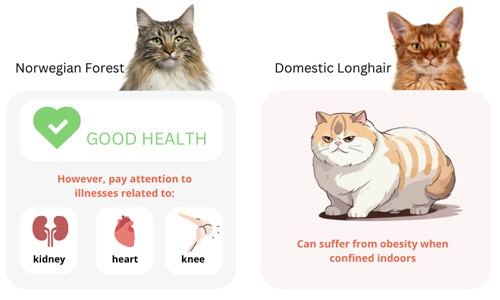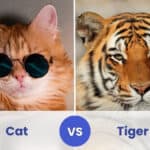To the untrained eyes, Norwegian Forest cats and Domestic Long Hair can look strikingly similar due to their fluffy long coat. However, they originated from separate parts of the world, with the former from Northern Europe and the latter from Asia.
The post below compares Norwegian Forest cat vs Domestic Longhair to help you distinguish them.
| Norwegian Forest | Domestic Longhair | |
| Length (Adult) | 9-12 inches
36 inches (including tail) |
8-10 inches long
30 inches (including tail) |
| Weight (Adult) | 18 lbs | 12 lbs |
| Origin | Northern Europe | Western Asia |
| Personality | Energetic | Harder to predict due to their mixed ancestry |
| Lifespan | 14–16 years | 15–18 years |
| Likely diseases | Kidney/Heart | Obesity/Genetic |
| Price | $75 to $500 | $900 to $2000 |
Table of Contents
Overview
1. Norwegian Forest Cats
Originating from Northern Europe, Norwegian Forest cats are a bulky breed with a long coat — a feature that helps them tolerate Norway’s cold climate.
However, many people believed that they were initially short-haired cats that the Vikings and Crusaders brought to Norway around 1000 A.D, where they were treasured for their superior mouse-hunting skill.
2. Domestic Longhair
Contrary to popular belief, Domestic Longhair isn’t an official breed due to its unknown heritage, meaning you can’t trace its ancestors’ breeds. As a result, Norwegian long hair cat is considered a pseudo-breed.
In other words, these cats aren’t really a result of Norwegian Forest cats mixed with Domestic Shorthair.
Although the Domestic Longhair originated from Western Asia, their long fur only developed when brought to Europe in the 15th century and bred with other feline breeds to adapt to the European climate.
Which Cat Breed is Right for You?
Below are a few factors to help you consider which is better suited for your home, lifestyle, and personal preferences.
1. Appearance and size
The Norwegian Forest cat has a thick double coat with long hair, particularly around the neck. While Domestic Longhair also has a double coat, their fur can either be semi-long or long, and they don’t always have a mane.
In terms of build, because they originated from a colder region, Norwegian Forest cats are more muscular and larger than even big house cats. So it comes as no surprise when they are noticeably larger than Domestic Longhair, especially with their longer coats.
Unfortunately, you can’t tell them apart based on just their cat colors, as they come in various colors, and their most common coat patterns are both mixed with tabby.
2. Personality
Norwegian Forest casts are energetic and playful. However, when around strangers, they can appear reserved and aloof. Although affectionate with their owners, they can do well on their own and don’t really tolerate cuddling.
As for Domestic Longhair, their mixed heritage means it’s hard to predict their personality; you can get anything between an aloof cat and an overly affectionate one. That said, they usually don’t crave too much attention and can get on well with kids.
One similar personality of Norwegian Forest cats and Domestic Longhair is that they both like to seek out mice in the vicinity and hunt.
3. Lifespan
The lifespan of Norwegian Forest cats is around 14 to 16 years. Meanwhile, Domestic Longhair can live from 12 to 18 years. Despite their shorter general lifespan, Norwegian Forest cats are less prone to genetic issues due to not being crossbred.
To ensure either cat lives long and healthy, you’ll need to clean their teeth regularly, brush their fur several times a week, and spay/neuter them.
4. Health
By and large, Norwegian long-haired cats have good health. However, the probability of them suffering from kidney or heart disease is higher. They’re also more susceptible to knee issues, which can prevent them from crouching or leaping.
Domestic Longhair can suffer from obesity when confined indoors, so be sure to get them to exercise regularly and eat reasonable portions. And since they are mixed-bred with unknown heritage, it’s best to adopt them from a certified breeder to avoid genetic issues.
5. Diet
Both Norwegian Forest cats and Domestic Longhair require protein-rich food at least twice a day. The exact amount of food you should give will depend on the cat’s size, age, and health condition, so it’s best to consult your vet. However, Norwegian cats tend to require more food due to their larger build.
6. Price
Because they don’t have a clear ancestry, Domestic Longhair cats are very affordable; most only cost $75 to $100. Even if you get one from a renowned breeder, the price never goes above $500 per kitten.
Although Norwegian Forest cats aren’t considered to be an expensive breed, they certainly aren’t cheap either. Typically, getting one from a certified breeder will set you back $900 to $1500, whereas high-pedigree cats will cost up to $2000.
Conclusion
When comparing Norwegian Forest cat vs Domestic Longhair, there is no clear winner, as each has its pros and cons. It’s best to understand your requirements and choose the one that meets them. Stick to the guide above; you shouldn’t have a problem choosing one.

I pursued veterinary studies at the University of Kansas. After several years of practice, I established a veterinary clinic in Kansas. When Michael extended an invitation with a vision that went beyond emergency support – sharing of caregiving information for guardians to create the best living environment for cats, I didn’t hesitate to join the organization.
My role here involves verifying the information presented on the official website. With my experience, I believe the information provided is entirely accurate. If you have any concerns, please feel free to reach out to me


